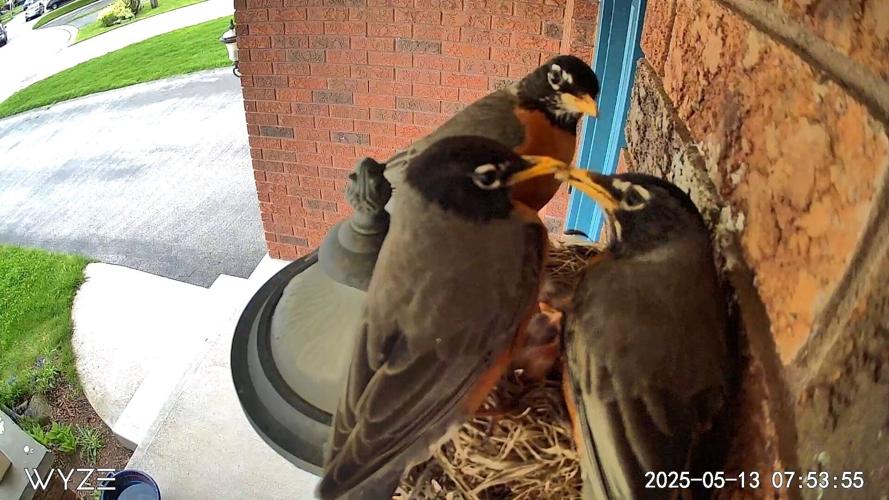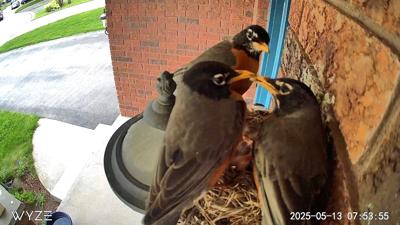The drama is soaring for one family of birds in the city of St. Thomas, Ont.
For the past four springs, Debra Lynn Copeland’s front porch has been a haven to numerous families of robins, the 40-year-old mom of three told the Star.Â
She was delighted to find a new nest on her porch light in late April this year — and even more so when two bright blue eggs appeared days later.
The next morning, that nest was home to four eggs. By the end of the day, there were six.
“I was starting to get a little suspicious, because robins don’t usually lay any more than five eggs,” she said. But it didn’t end there.
The next day, Copeland had to do a “total double take” on her way out the door because a whopping eight eggs had appeared in the tiny nest.
“I was like, we have to put a camera up,” she said.Â
To her surprise and confusion, the camera captured two female robins sitting in the same nest — and they did not appear to get along.

The two stubborn female birds perform a passive-aggressive wrestling match for incubation rights in the nest.
Debra Lynn CopelandThe birds would squabble, bite and peck at each other’s heads and beaks, but neither were willing to give up the nest. As the days passed, the moms appeared to cool their tempers and settled for sitting in the same nest — one right on top of the other.
“That is super weird because robins are extremely territorial. They do not want any other robins coming near their nest,” Copeland said.
Puzzled, on Facebook group “Backyard Bird Lovers,” asking whether anyone had seen such a thing. The post soon racked up over 1,000 reactions as puzzled bird fanatics flocked to comment.
“I never knew any bird would share her nest with another female,” one wrote. “There might not be room for all the babies,” another mused.
Ornithologists weren’t sure what to make of the situation, either: “It’s very unusual,” Jim Quinn, a professor emeritus of biology at McMaster University, told the Star.
Robins usually only have one mate at a time during breeding season — that said, “American robins are notoriously unfaithful,” Quinn said with a laugh. “There are many cases where the putative father is not the genetic father, so there’s some hanky-panky going on in those families.”
As for the two moms sitting on each other, Quinn classified it as “fighting, but in a very mild kind of way … one bird was incubating, the second bird was trying to take over incubation, and the first one was resisting in a very kind of passive way.”
After days of passive-aggressive nest wrestling, Copeland said a male robin showed up to deliver grubs to the moms and check up on the eggs. And, on Mother’s Day, the first of the eggs finally hatched.
Over the next few days, six of the eight eggs yielded tiny, chirping hatchlings — spurring dad and both moms to hunt for food. All the while, Copeland kept the Facebook group updated on what she called the “Avian Sister Wives.”

The first of the six hatchlings broke free of its shell on Mother’s Day.
Debra Lynn CopelandWhile unusual, there have been rare instances of robin polygamy recorded in the past, according to Nicola Koper, an ornithologist and dean of the University of Northern British Columbia’s Faculty of Environment.
She speculated that, most likely, one of the two moms had no social mate to help in raising the babies: “It’s a situation where the male is a biological father but doesn’t actually help raise the kids,” she said. In other words, a deadbeat dad.
This single mom’s solution may have been to lay her eggs in another’s nest: “So possibly what’s going on is there’s a male who has basically two wives. He’s got a primary wife who built the nest, and he’s got a second wife who was having her own problems, couldn’t find sufficient housing and moved into the house with his first wife,” Koper suggested.
But Copeland made an observation that may throw a wrench in that theory. Although only three birds were ever seen at the nest at any one time, she began to feel there were two dads.
“There are different markings on their beaks and their eyes” of the male birds, she said. “I don’t know, but I really do think there are two whole couples.”
Koper said it was possible — perhaps the original mom was “seeing someone on the side” and “things got really complicated” to the point the nest became a “commune” of free bird love. But it’s likely impossible to say what’s happening for sure.
“The best part of being an ornithologist is sometimes not knowing for sure why you’re seeing something amazing,” she said in a followup email. “I still feel curiosity, awe, and joy watching birds, and wondering why the heck they are doing something unusual.”
In any case, Koper believes the polygamous bird family may actually be beneficial for the young hatchlings. With more adults around, there’s less chance of predation — and because all three (or four) parents are helping to hunt for food, the babies are more likely to be well-fed.
As for Copeland, she feels grateful that the bird commune chose her porch as their home.
“I feel bonded to them, I’m looking forward to their completing this journey,” she said. “I am just thrilled that they have done this here at my house and have blessed me with such a joy, to watch such an interesting and fascinating story unfold right on our porch.”






























To join the conversation set a first and last name in your user profile.
Sign in or register for free to join the Conversation